When you’re hitting the open road in your RV, there’s one question that comes to mind more often than you’d expect: What happens when you flush the toilet? It’s not the most glamorous topic, but it’s one every RVer needs to understand. Whether you’re new to RV life or just curious about the differences, knowing how your RV toilet works—and how to handle it—can save you a lot of trouble on the road. From the type of toilet paper to use to managing waste and avoiding clogs, we’re diving into everything you need to know about RV toilet essentials.
Table of Contents
Where does RV bathroom waste go?
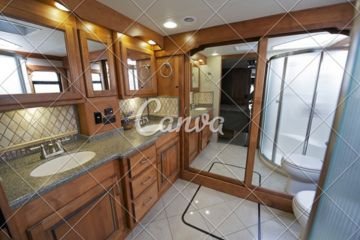
A burning question that every newbie camper asks: Where does the waste go when we use the latrine in an RV? Well, let me tell you, it’s not as complicated as it might seem, but it is definitely something that you’ll have to know about.
When you flush in an RV, the waste doesn’t just magically disappear. It gets stored in a special tank called the black water tank. This tank is specifically designed to hold the toilet waste. Think of it as a portable storage system that’s there to do the dirty work so you don’t have to worry—well, not right away at least.
Once the tank is full, you must have to empty it at any dump station. Yes, it can sound a little intimidating at first, but trust me, with the right tools and a little practice, it is very pretty straightforward. However, the key is to understand how to handle it properly so you don’t run into any unpleasant surprises (because no one wants that, right?).
The process is clean, organized, and designed to make camper life easier for you. So, don’t worry! Just be familiar with that, yes, your waste has a place to go, and it won’t be a hassle once you get the hang of it.
Types of RV Waste Management Systems
When it comes to managing your RV waste, there’s more than one way to handle what happens after you flush. And believe me, knowing the difference can make your RV life so much easier! Because after that you will identify which system is best for your comfort. Let’s break it down.
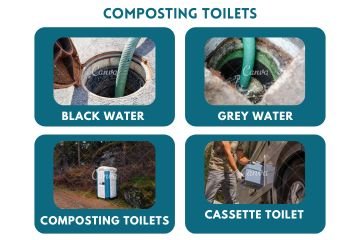
Black Water tank
First, we have the black water tank system. This is the most common one among the campers and the travelers. The black water tank is strictly for toilet waste—nothing else goes in here. It’s like a mini septic tank traveling with you. And yes, it needs to be emptied regularly at a dump station, but don’t worry, it’s built for the job.
Grey Water tank
Then there’s the grey water tank. This one’s for wastewater from your sinks and shower. Think of it as where all that soapy water goes after you wash your hands or do the dishes. While it’s not as gross as the black tank, it still needs to be managed. You’ll empty it the same way, at a dump station, or directly into a sewer hookup if you’re at a full-service campsite.
Composting toilets
For those who want something a little different, some RVs come with composting toilets. These don’t use water and as a substitute, turn waste into compost! It’s an eco-friendly option but requires a bit more effort in terms of maintenance.
Cassette toilets
And lastly, there are cassette toilets—a smaller, portable version of the black tank system. These are more common in compact RVs and campervans. You simply remove the cassette (a portable tank) and empty it manually at any dump station.
The RV toilet? How does an RV restroom work?
Ah, the RV toilet—a bit of rocket science for newcomers, but once you understand how it works, it becomes just another part of your traveling adventure! So, let’s dive into it.
The first thing to note is that an RV toilet is similar to a regular toilet in terms of functionality, but the handling process of an RV toilet is different from that of a standard toilet.
RV toilets are connected to a black water tank whereas the standard home toilets are connected to a sewage system. Every time you flush, the waste drops straight down into this tank. These tanks are designed to collect and store everything until you’re ready to empty it. You can use a foot pedal or a button to flush, and water will flow in to help with waste management and cleaning, but it’s kept minimal to preserve water since you’re on the road.
How Water is collected in the Tank
The water that you use in your RV toilet comes from the freshwater tank. When you flush, a small amount of water helps to push the waste into the black tank. This water not only helps things move along but also keeps odors under control (which is a lifesaver when you’re on the road!).
How Often Do You Need to Empty an RV Toilet?
Now, the million-dollar question: how often do you need to empty the RV toilet? Well, it really depends on a few things like—how many people are using the toilet and how much water is being flushed each time.
On average, a family of two persons might need to empty the black tank after every 4–7 days. If you’ve got more people on board, you might be observing the tank after every 3–5 days.
Here’s a technique that I use: don’t wait until the tank is overflowing! Most RVs have an indicator light or a gauge that shows you how full the tank is.
Keep an eye on it, and try to empty the tank when it’s about three-quarters full to avoid any messes.
How Long Can RV Waste Stay in the Tank?
Ideally, you don’t want to leave waste in the tank for too long. It’s recommended to empty the tank every 5–7 days, even if it’s not full. Why? Because the longer waste sits in the tank, the more likely it is to cause odors or buildup which make things harder to clean later on. Also, if you’re camping in warm weather, that waste can start to break down quicker, causing smells to creep into the RV. No one wants that!
The good news? Using RV-specific chemicals can help break down waste and keep things smelling fresh for a little longer. But, trust me, don’t stretch it too long—empty that tank regularly and you’ll save yourself from some very unpleasant surprises.
Maintaining the Motor Home Lavatory
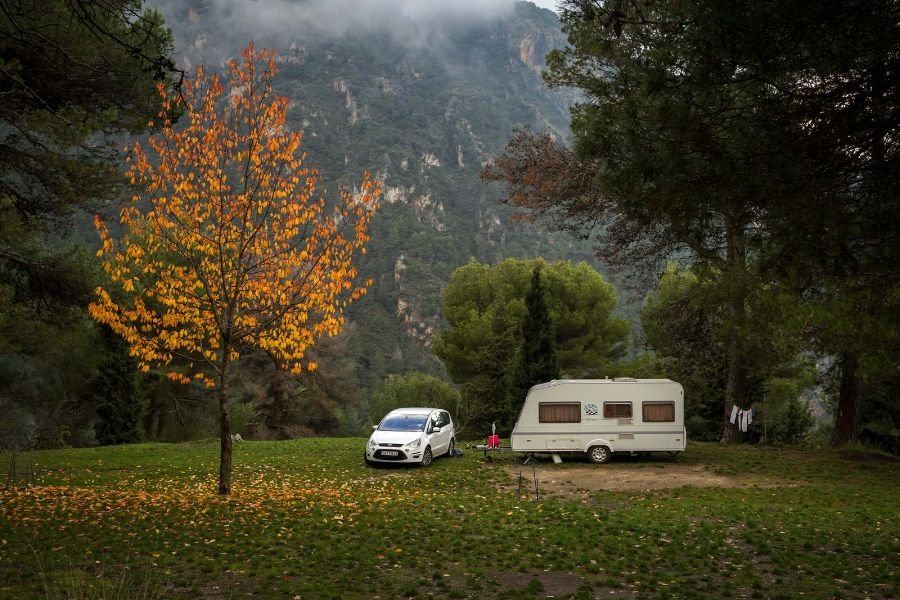
Keeping your RV bathroom in tip-top shape doesn’t have to be a huge hassle, but a little attention can go a long way in avoiding those feared clogs or unpleasant odors. Let’s get into some simple but crucial tips for maintaining your motor home lavatory!
Some Cleaning Tips to Avoid Clogs and Other Issues
Ah, clogs—the RVer’s nightmare. But trust me, they’re absolutely avoidable!
First, always use RV-friendly toilet paper. Regular household toilet paper might seem fine, but it doesn’t break down as easily in the black tank and can cause serious backups. Choose toilet paper that’s designed to dissolve quickly to keep your system flowing smoothly.
Another tip? Don’t be shy about using plenty of water when you flush. It might feel odd or illogical to use extra water when you’re trying to conserve it, but the more water that goes down with your waste, the less likely you’ll have to deal with blocks.
Lastly, clean your toilet regularly, especially around the seal. Wipe it down to prevent build-up and ensure a tight seal, which helps keep odors locked away.
Should You Use Toilet Chemicals to Break the Waste and Reduce Odors?
Absolutely! This is one of the most important things you can do to keep your RV bathroom smelling fresh and avoid nasty waste build-up. Toilet chemicals are designed specifically for campers to break down solid waste and reduce those unpleasant aromas that can sneak up on you, especially in the summer heat.
These chemicals come in liquid, powder, or even in powder form, and they help not only with odor control but also with breaking down toilet paper and waste which makes it easier to empty the black tank when the time comes. Without them, waste can harden and become a nightmare to flush out. So, yes, these chemicals are your best friend!
Some of the Best RV Toilet-Friendly Materials You Need to Know About
Okay, let’s talk about basics! When it comes to RV toilets, not all materials are created equal.
First on the list? RV-specific toilet paper. I can’t stress this enough! This toilet paper is intended to break down quickly in your tank and help to prevent clogs. It might feel a little thinner than what you’re used to at home, but it’ll save you from bigger headaches.
Another great product is tank treatment pods or liquid deodorizers. These help keep the tank clean, reduce odors, and break down waste.
And don’t forget about a good-quality black tank flush hose—it helps clean the tank thoroughly after emptying.
Oh, and here’s something many RVers don’t realize until it’s too late: avoid flushing anything but toilet paper and waste. No wet wipes, no tissues, and definitely no feminine hygiene products. Even if the package says “flushable,” they can inflict a type of destruction on your RV system.
Troubleshooting Common Issues of RV Toilet
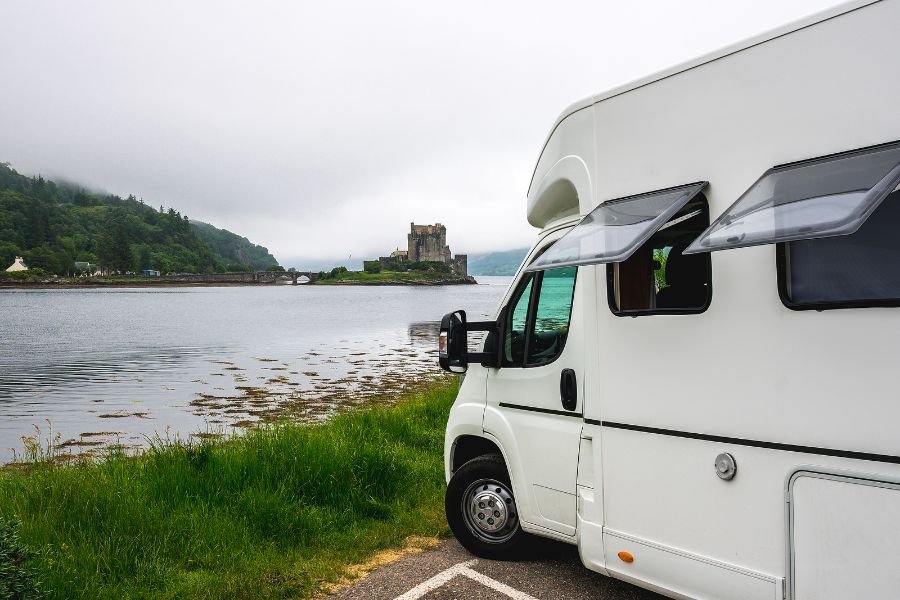
Even with the best care, trailer toilet issues can still happen. And trust me, it’s better to know what to do beforehand than to be caught off guard! Let’s walk through some common problems and, more importantly, how to solve them.
What to Do If the Black Tank Overflows or Leaks
Okay, this is one of the worst scenarios, right? An overflowing or leaking black tank is not just inconvenient—it can get messy. First off, don’t panic. If your black tank is overflowing, immediately stop using the toilet. If you’re at a campsite, hook up to the sewer connection or head to a dump station as fast as possible to empty the tank.
If the issue is a leak, you’ll want to inspect where it’s coming from. Sometimes it’s as simple as a loose connection with the hoses, and tightening them will fix it. If it’s leaking from the tank itself, though, it could be a crack or faulty seal, which may need professional attention. Either way, it’s crucial to wear gloves and take proper safety measures to avoid contamination.
How to Fix Clogs in the Toilet or Tanks
Clogs can be a major pain, but they’re fixable! If your toilet seems clogged, try adding a good amount of hot water (not boiling) into the toilet bowl and flushing it through. This can sometimes help break down the clog.
You can also use an RV-friendly plunger to dislodge the blockage.
If the clog is in the black tank, you’ll need to take a different approach. Add a chemical treatment or enzyme-based cleaner to the tank and let it sit for a few hours or even overnight to break down waste.
If that doesn’t work, some RVs have a tank flush system you can hook up to a water source to rinse out the tank.
If things are really stuck, you may need to use a black tank wand—a tube attachment that sprays water into the tank to break up clogs.
Solution for Bad Odors
Nobody wants their RV to smell like a portable toilet! If you’re getting bad odors, the first thing to check is whether the tank needs to be emptied. Sometimes, even if the tank isn’t full, waste sitting in there for too long can cause a stink. Empty the tank and rinse it out thoroughly.
Another cause could be that your toilet seal isn’t doing its job. If the seal isn’t tight, odors can seep through. Cleaning the seal and applying a bit of plumber’s grease can help it stay tight and prevent smells from escaping.
Lastly, toilet chemicals are vital. If you aren’t using them or are using too little, waste isn’t breaking down properly, which leads to bad smells.
So, Make sure you’re using enough and that it’s the right kind for your RV. You can also add deodorizers directly to the toilet or black tank for an extra layer of freshness.
Emptying the Caravan Water Tank
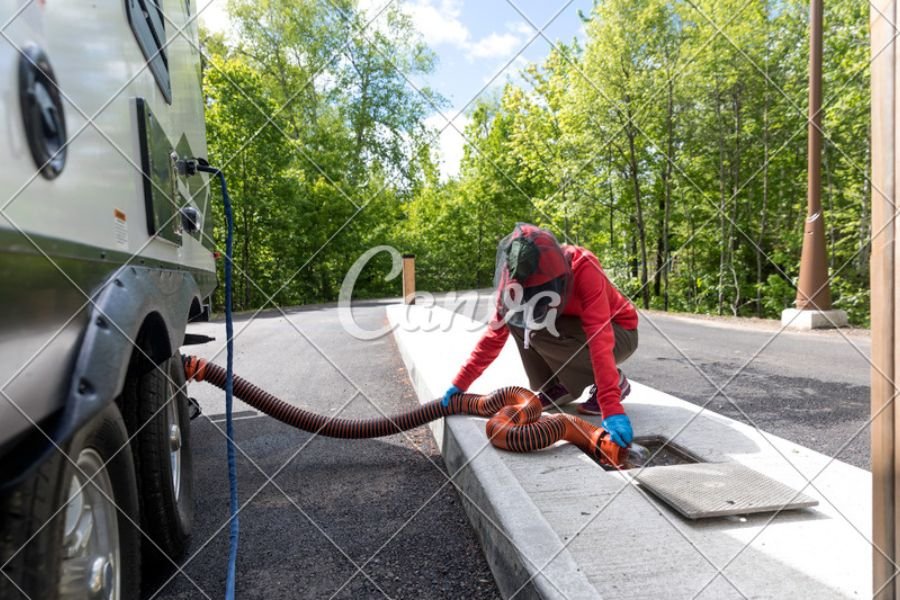
Emptying the black water tank can sound like a daunting task, especially if you’re new to RVing, but once you get the hang of it, it’s just part of the routine. Let’s break it down, step by step, so you know exactly what to do and what you’ll need. Trust me, with a little practice, it becomes second nature!
How to Empty the Black Water Tank at a Dump Station
First, when you’re ready to empty the black water tank, make sure you’re parked close enough to the dump station so your hose can easily reach the connection point. Once you’re all set:
- Connect the Sewer Hose
- Attach one end of the sewer hose to your RV’s black tank valve (make sure the valve is closed before doing this!), and the other end goes into the dump station’s drain. Double-check the connection on both sides to ensure it is secure—this is not something you want to come loose!
- Empty the Black Tank
- Now, carefully open the black tank valve. You’ll hear the waste flowing through the tube. Give it time until the tank is completely empty. You might want to step back during this part—just for comfort’s sake!
- Flush the Tank (Optional but Recommended)
- If your trailer has a tank flushing system, use it now. This will rinse out any leftover waste and prevent buildup. If you don’t have a built-in system, you can pour water down the toilet or use a hose attachment to manually rinse the tank.
- Close the Valve and Disconnect
- Once the tank is empty, close the black tank valve before detaching the hose. This step is crucial! After disconnecting, rinse the sewer hose using the dump station’s water hose to keep everything clean.
- Dispose of Everything Properly
- Make sure the dump station cover is securely closed, and pack away your hose and accessories.
What is the difference between a regular toilet and an RV toilet?
Here’s a table that compares the differences between a regular toilet and an RV toilet:
| Feature | Regular Toilet | RV Toilet |
|---|---|---|
| Water Supply | Continuous water supply from home plumbing. | Limited water from the RV’s freshwater tank. |
| Waste Management | Waste goes directly into the sewage system or septic tank. | Waste is stored in a black water tank, which must be manually emptied at a dump station. |
| Flushing Mechanism | Gravity-based flushing with ample water flow. | Uses a foot pedal or button to control the amount of water per flush, with minimal water use. |
| Space and Design | Larger with various designs, built for comfort. | Compact and lightweight, designed to save space and reduce weight. |
| Types of Toilets | Standard flush toilets. | Various types, including traditional flush, cassette, and composting toilets. |
| Cleaning and Maintenance | Minimal, with occasional cleaning and maintenance. | Requires regular maintenance, including the use of toilet chemicals and frequent cleaning of seals. |
FAQs
Do I need to use RV toilet paper?
Yes, and I can’t stress this enough! RV toilet paper is designed to break down quickly in the black tank, which helps prevent clogs. Regular toilet paper might seem fine at first, but trust me, over time, it can cause serious issues. You don’t want to deal with a clogged black tank on a camping trip—that’s a mess no one wants to handle!
Can you flush toilet paper in an RV?
Yes, you can flush toilet paper in an RV, but only if it’s the right kind. Stick to RV-specific toilet paper, which dissolves faster and keeps your system running smoothly. If you use regular toilet paper, it might not break down properly, which can lead to clogs and some nasty problems.
Should you poop in your RV?
Absolutely, your RV toilet is made for it! Some people feel a little hesitant at first, but don’t worry—it’s completely normal to use your RV toilet for everything. Just make sure you use enough water when you flush to help waste move through the system and break down. The black tank and chemicals are aimed to handle it all, so you don’t need to be stressed.
Should you keep a black tank open or closed?
Always keep it closed until you’re ready to dump. If you leave it open, liquids will drain out, but solids can build up in the tank, which leads to a blockage called a “poo pyramid” (yes, it’s as bad as it sounds!). Keeping the tank closed lets everything mix with water, breaking down solids and making it easier to empty when the time comes.
Should I leave water in my black tank when not in use?
Yes, you should leave a little water in the black tank, even when you’re not using it. A small amount of water at the bottom helps prevent waste from sticking and drying out, which can cause some unpleasant build-up. Adding a bit of water and a cleaning solution or chemical can also help keep things fresh until your next trip!
Can you dump RV waste in the toilet?
Technically, you can, but I think it’s not a great idea. Dumping RV waste into a regular toilet at home or a public restroom can be messy and isn’t really designed for it. It’s better—and easier—to go to an RV dump station where everything is set up for properly handling waste. Plus, many toilets aren’t made to handle the quantity and type of waste that comes from an RV.
How do campers go to the toilet?
Most campers, especially those in RVs, use their built-in toilet or head to a campground restroom. If you’re boondocking (camping without hookups), you’ll rely on your RV’s toilet and need to monitor your black tank’s capacity. Some tent campers bring portable toilets or use composting systems. It all depends on where you’re camping and what facilities are available!
Where does motor caravan shower water go?
The water from your RV shower goes into the grey water tank. This is different from the black tank (which is for toilet waste). The grey water tank collects water from sinks and showers, and while it’s not as dirty as black water, it still needs to be emptied at a dump station. So keep an eye on that tank, especially if you’re showering frequently!
Conclusion
At first, managing an RV toilet can feel like a daunting task, but once you get the hang of it, it becomes part of the adventure. By understanding how your RV’s waste system works, using the right materials, and keeping up with regular maintenance, you’ll have peace of mind knowing everything is running smoothly behind the scenes. After all, the less you have to worry about your RV’s bathroom, the more time you can spend enjoying the journey ahead!
You May Also Like

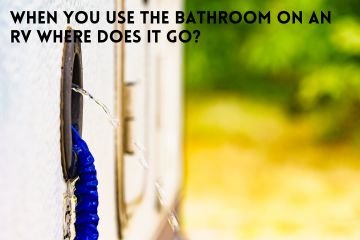
Pingback: What kind of septic system do I need for my RV? 2024